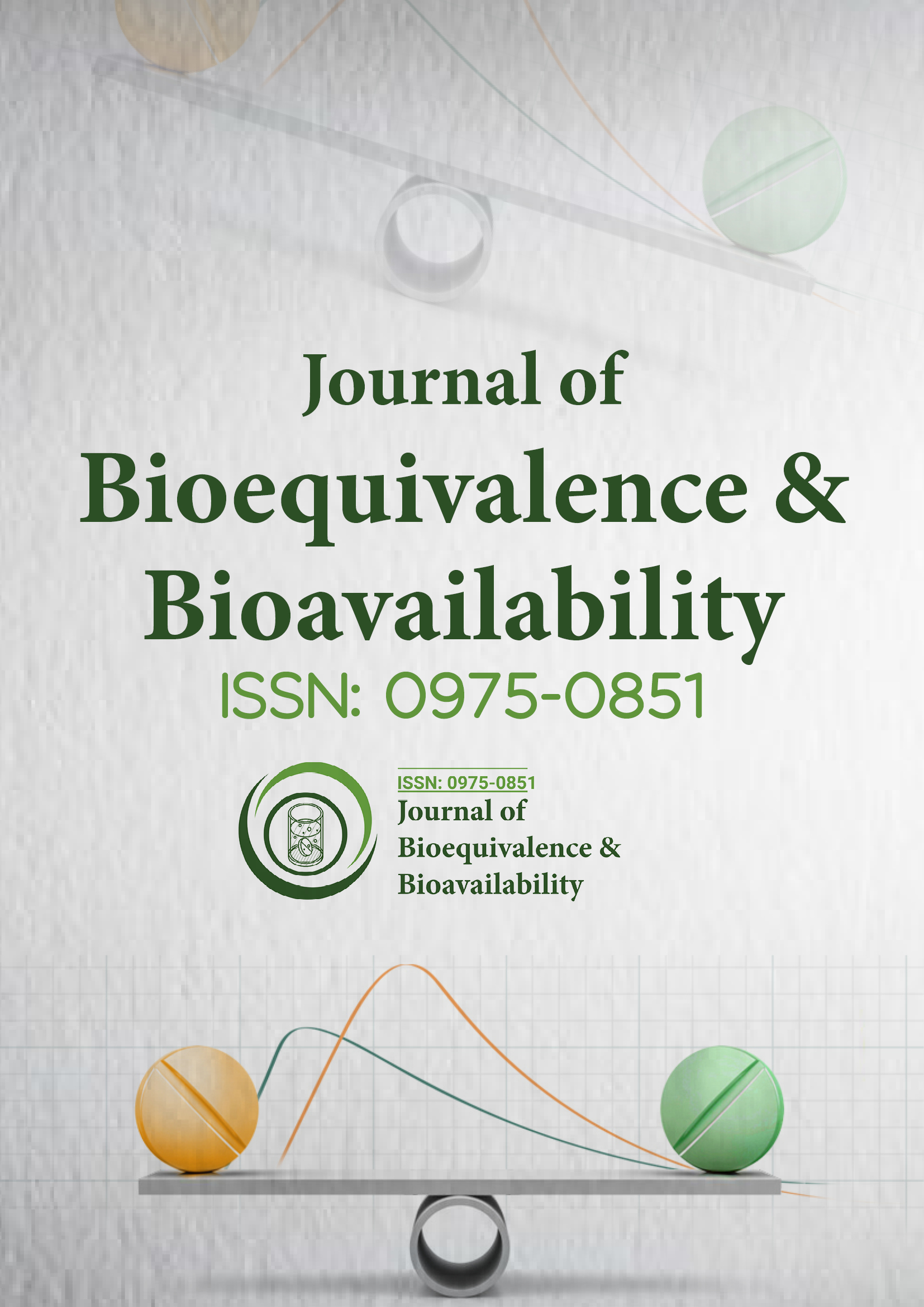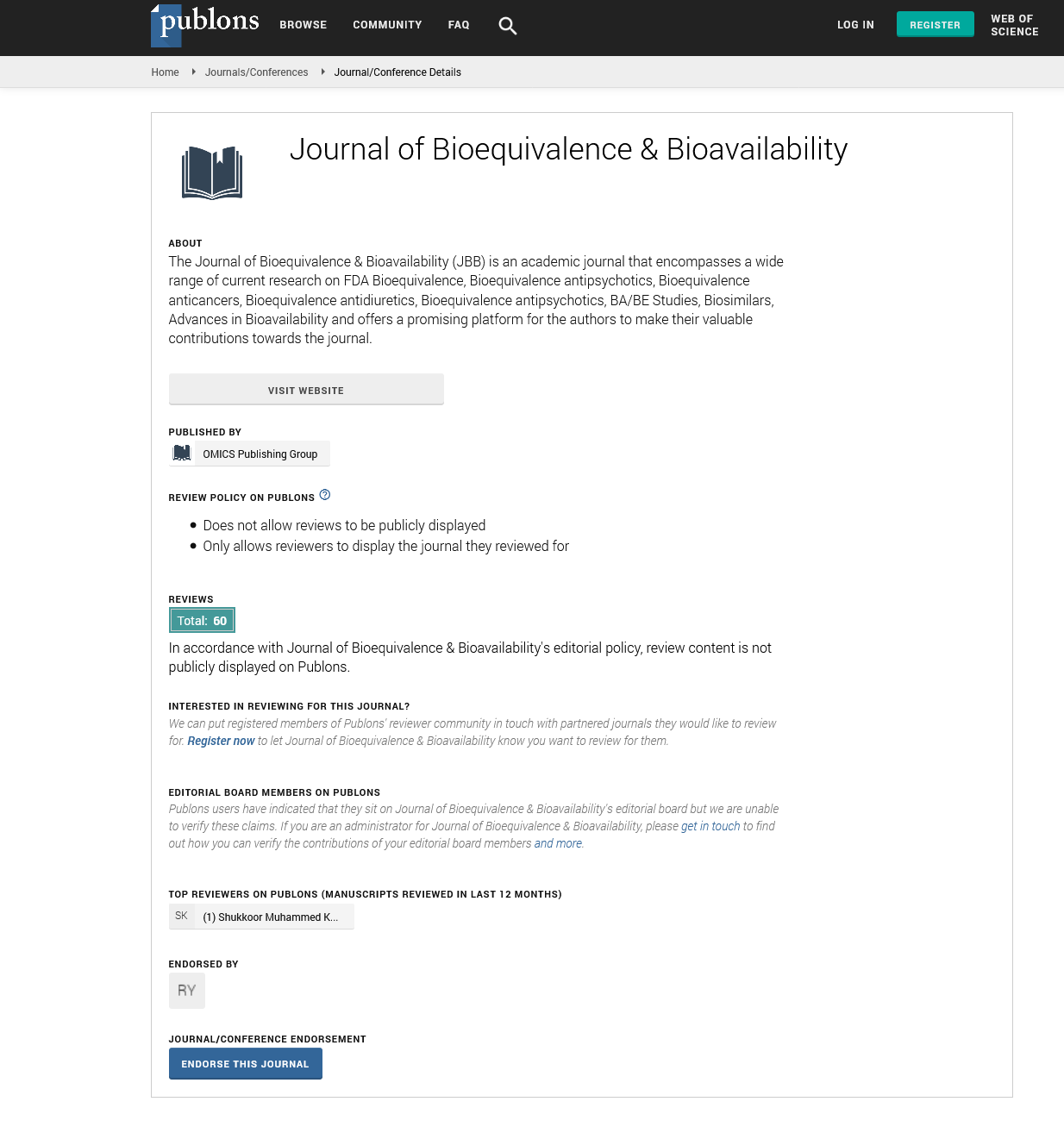Indexed In
- Academic Journals Database
- Open J Gate
- Genamics JournalSeek
- Academic Keys
- JournalTOCs
- China National Knowledge Infrastructure (CNKI)
- CiteFactor
- Scimago
- Ulrich's Periodicals Directory
- Electronic Journals Library
- RefSeek
- Hamdard University
- EBSCO A-Z
- OCLC- WorldCat
- SWB online catalog
- Virtual Library of Biology (vifabio)
- Publons
- MIAR
- University Grants Commission
- Geneva Foundation for Medical Education and Research
- Euro Pub
- Google Scholar
Useful Links
Share This Page
Journal Flyer

Open Access Journals
- Agri and Aquaculture
- Biochemistry
- Bioinformatics & Systems Biology
- Business & Management
- Chemistry
- Clinical Sciences
- Engineering
- Food & Nutrition
- General Science
- Genetics & Molecular Biology
- Immunology & Microbiology
- Medical Sciences
- Neuroscience & Psychology
- Nursing & Health Care
- Pharmaceutical Sciences
Short Communication - (2025) Volume 17, Issue 1
Regulatory Challenges in Bioequivalence Studies of Highly Variable Drugs
Lexi Snow*Received: 03-Feb-2025, Manuscript No. JBB-24- 28948; Editor assigned: 05-Feb-2025, Pre QC No. JBB-24- 28948 (PQ); Reviewed: 18-Feb-2025, QC No. JBB-24- 28948; Revised: 25-Feb-2025, Manuscript No. JBB-24- 28948 (R); Published: 04-Mar-2025, DOI: 10.35248/0975-0851.25.17.625
Description
Regulatory compliance in Bioequivalence (BE) studies is a cornerstone of modern pharmaceutical development, particularly in the context of generic drug approval. Ensuring regulatory adherence is not simply a bureaucratic necessity; it is a safeguard for public health, a mechanism to build industry trust, and a means to guarantee that generic products offer the same safety and efficacy as their branded counterparts. The foundation of regulatory compliance in BE lies in meeting rigorous scientific standards while aligning with the nuanced requirements of national and international health authorities [1].
One of the key aspects of regulatory compliance is the design of the study itself. Regulators expect BE studies to be scientifically rigorous and methodologically sound [2]. This typically involves a randomized, crossover design, where healthy volunteers receive both the test and reference formulations under standardized conditions. Parameters such as sample size, washout period, and selection of subjects are meticulously reviewed to ensure statistical power and minimize variability. Regulatory agencies often mandate the inclusion of both fasting and fed conditions, particularly for drugs with known food effects, and require studies to be performed using validated analytical methods under Good Laboratory Practice (GLP) and Good Clinical Practice (GCP) guidelines [3].
Documentation and transparency are also integral to regulatory compliance. Every phase of a BE study must be recorded and justified, from protocol development and ethics committee approval to data analysis and reporting [4]. Regulatory bodies scrutinize raw data, subject logs, analytical validation reports, and adverse event records to ensure that the study was conducted ethically and scientifically. Any deviations from protocol must be explained and justified. Incomplete or poorly documented studies, regardless of their outcomes, often result in rejection. Thus, regulatory compliance is as much about scientific robustness as it is about thorough and honest reporting [5].
Moreover, the analytical methods used to quantify drug concentrations in plasma or other matrices must be fully validated according to regulatory requirements. Parameters such as accuracy, precision, linearity, sensitivity, and specificity are evaluated during method validation. Regulatory agencies routinely audit laboratories to verify compliance with GLP. Any lapse in sample handling, storage conditions, or calibration procedures can lead to questions about the validity of the entire study, emphasizing that regulatory compliance is comprehensive, extending from clinical procedures to laboratory analytics [6].
Compliance also involves consideration of ethical aspects, a requirement embedded in all international regulatory guidelines. Informed consent from all study participants is mandatory, and the clinical trial protocol must be approved by an independent ethics committee. Additionally, there must be clear procedures in place to handle adverse events, protect participant confidentiality, and ensure data integrity. Non-compliance with ethical standards can not only jeopardize regulatory approval but can also damage the reputation of the research institution or sponsor [7].
Pharmaceutical companies that invest in building strong regulatory affairs teams and quality assurance systems are better positioned to meet these compliance expectations. Proactive engagement with regulatory agencies through pre-submission meetings, scientific advice sessions, and post-submission interactions can help clarify expectations and reduce the risk of regulatory setbacks. A collaborative and transparent approach to regulatory compliance is increasingly recognized as best practice, aligning the goals of drug developers and regulators in ensuring public health [8].
In conclusion, regulatory compliance in bioequivalence studies is not a mere formality but a critical element of drug development that ensures public trust, scientific integrity, and equitable access to quality medications [9]. It involves a multidimensional approach encompassing study design, ethical conduct, analytical validation, data transparency, and global harmonization. As the pharmaceutical industry continues to grow and evolve, the standards for regulatory compliance must also be continuously reassessed and reinforced. Only by maintaining a robust and adaptive regulatory environment can we ensure that generic drugs fulfill their promise of safe, effective, and affordable healthcare for all [10].
References
- Subhani S, Kim C, Muniz P, Rodriguez M, Van S, Suarez E, et al. Application of physiologically based absorption and pharmacokinetic modeling in the development process of oral modified release generic products. Eur J Pharm Biopharm. 2022;176:87-94.
[Crossref] [Google Scholar] [PubMed]
- Habet S. Narrow Therapeutic Index drugs: Clinical pharmacology perspective. J Pharm Pharmacol. 2021;73(10):1285-1291.
[Crossref] [Google Scholar] [PubMed]
- Gozzo L, Caraci F, Drago F. Bioequivalence, drugs with narrow therapeutic index and the phenomenon of biocreep: a critical analysis of the system for generic substitution. Healthcare (Basel). MDPI. 2022;10(8):1392.
[Crossref] [Google Scholar] [PubMed]
- Vinarov Z, Abdallah M, Agundez JA, Allegaert K, Basit AW, Braeckmans M, et al. Impact of gastrointestinal tract variability on oral drug absorption and pharmacokinetics: An UNGAP review. Eur J Pharm Sci. 2021;162:105812.
[Crossref] [Google Scholar] [PubMed]
- Maurer AH. Gastrointestinal motility, part 2: small-bowel and colon transit. J Nucl Med Technol. 2016;44(1):12-8.
[Crossref] [Google Scholar] [PubMed]
- Hofsäss MA, Dressman J. Suitability of the z-factor for dissolution simulation of solid oral dosage forms: potential pitfalls and refinements. J Pharm Sci. 2020;109(9):2735-45.
[Crossref] [Google Scholar] [PubMed]
- Jinno JI, Kamada N, Miyake M, Yamada K, Mukai T, Odomi, et al. Effect of particle size reduction on dissolution and oral absorption of a poorly water-soluble drug, cilostazol, in beagle dogs. J Control Release. 2006;111(1-2):56-64.
[Crossref] [Google Scholar] [PubMed]
- Mudie DM, Samiei N, Marshall DJ, Amidon GE, Bergström CA. Selection of in vivo predictive dissolution media using drug substance and physiological properties. AAPS J. 2020;22:1-3.
[Crossref] [Google Scholar] [PubMed]
- Bego M, Patel N, Cristofoletti R, Rostami-Hodjegan A. Proof of concept in assignment of within-subject variability during virtual bioequivalence studies: propagation of intra-subject variation in gastrointestinal physiology using physiologically based pharmacokinetic modeling. AAPS J. 2022;24(1):21.
[Crossref] [Google Scholar] [PubMed]
- An Z, Wang X, Li P, He J, Liu L. Exploring the metabolic characteristics and pharmacokinetic variation of paroxetine in healthy volunteers using a pharmacometabonomic approach. J Pharm Biomed Anal. 2021;204:114224.
[Crossref] [Google Scholar] [PubMed]
Citation: Snow L (2025). Regulatory Challenges in Bioequivalence Studies of Highly Variable Drugs. J Bioequiv Availab. 17:625.
Copyright: © 2025 Snow L. This is an open-access article distributed under the terms of the Creative Commons Attribution License, which permits unrestricted use, distribution, and reproduction in any medium, provided the original author and source are credited.

